13-inch Retina MacBook Pro Review (Late 2012)
by Anand Lal Shimpi on November 13, 2012 2:53 AM ESTAll Flash Storage
Until NGFF gains traction in the market, SSDs with a custom physical design are going to be the norm in any system that aggressively prioritizes form factor. There has been at least some standardization within the Apple camp this past year. The 2012 iMac, Mac mini, MacBook Air and Retina MacBook Pros all use the same custom SATA+power connector on their SSDs. The standard 2012 MacBook Pro still uses a 2.5" SATA SSD as it needs to easily swap positions with a mechanical hard drive depending on what the customer orders.
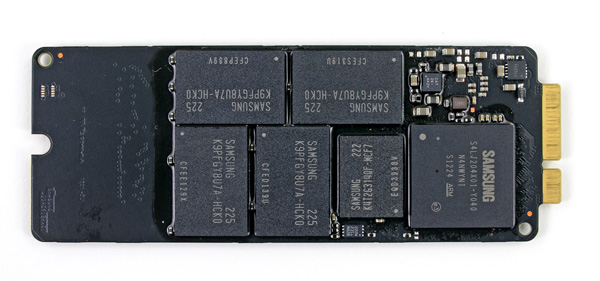
13-inch rMBP SSD module, image courtesy iFixit
The 13-inch rMBP goes one step further and uses the same physical SSD module that Apple uses in the 15-inch model. In the past Apple has used Samsung PM830 based SSDs for any drives larger than 128GB (so 256GB, 512GB and 768GB), which meant all of the 15-inch rMBPs got Samsung drives.
The 13-inch rMBP starts at 128GB however, which means there could be a chance you'll end up with a Toshiba/SandForce based solution in your Mac. Depending on your usage model (e.g. if you're going to enable FileVault), this could be undesirable. So far, all of the 128GB 13-inch rMBPs I've encountered use Samsung based drives.
As always, the easiest way to tell who makes the controller on your drive is to run a system report and look at the prefix on the drive itself: SM for Samsung and TS for Toshiba.
Performance of the PM830 based solution is quite good:
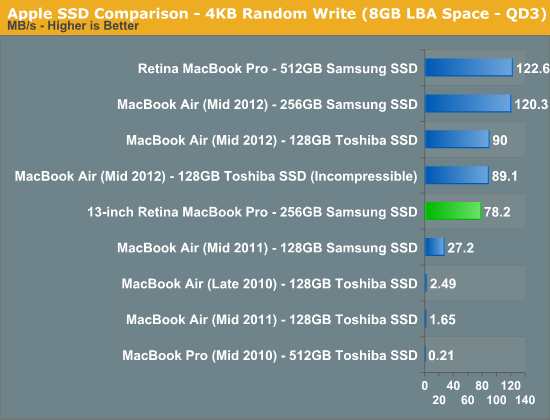

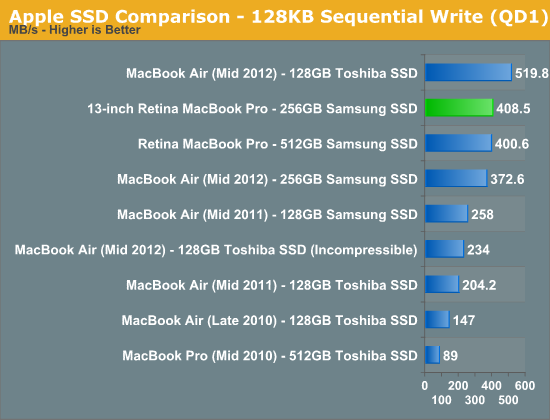
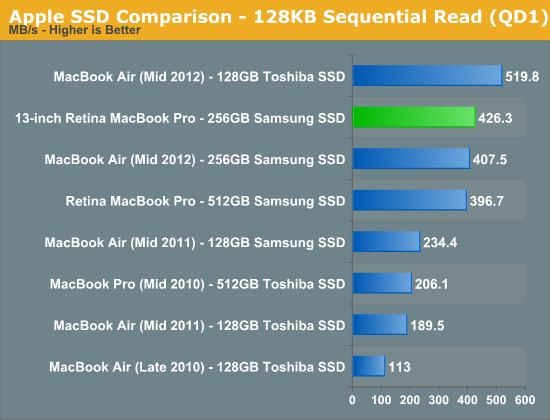
As expected, you get the same performance from the storage solution in the 13-inch rMBP as you would from the 15-inch model.
Samsung's PM830 was the controller of choice when the 15-inch rMBP hit, however now there are some interesting options available on the market. Samsung's latest MDX controller, used in the 840 Pro, will likely make its way to Apple's lineup next year. Intel's S3700 controller however provides a new optimization point for SSDs. I would love to see Apple work closely with Intel on bringing a mobile-friendly version of the S3700 to its notebooks. Although Samsung's drives have been my pick for Mac users for quite a while now, OS X doesn't respond well to unexpectedly high IO latency. As I showed in our review of Intel's SSD DC S3700, even Samsung's 840 Pro doesn't do a great job of delivering consistent random IO latency. The S3700's power profile alone will keep it out of any Apple notebooks, but there's nothing fundamentally power hungry about the controller's architecture. Apple needs the S3700 or something similar as it looks for ways to improve IO performance going forward.
Integrated SDXC Card Reader: Performance and Compatibility
The port layout remains consistent between the 13 and 15-inch rMBPs, which means that the 13-inch model retains an integrated SD card slot. The slot is mechanically different than the one used on the 15-inch model, with an inserted SD card sticking out a lot more on the 13 than it would on the 15.
SD card compatibility was measurably worse on my review sample compared to the 15-inch rMBP. I tried Patriot's EP Pro UHS-I and Patriot's LX series cards, neither of which would reliably work on the machine. I usually got disconnect errors if I even slightly moved the notebook with the EP Pro in the reader. The behavior was quite erratic. On several insertions the problematic cards worked fine, only to go back to failing regularly a few hours later. My SanDisk Ultra microSD card in a SD card adapter worked just fine on the other hand.

Performance on the reader was on-par with the 15-inch rMBP. When I could get the EP Pro working I measured around 80MB/s for reads from the card and 40MB/s when writing to the card:



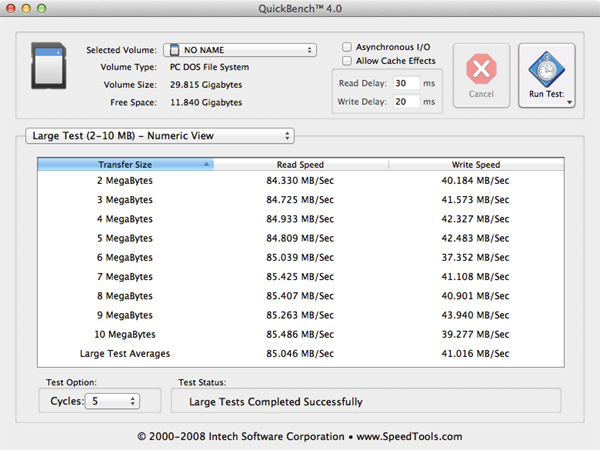








79 Comments
View All Comments
TEAMSWITCHER - Tuesday, November 20, 2012 - link
I'm not so sure....If you take a 13" MacBook Air and upgrade the specs with a 2.0GHz processor, 8 GB of ram, and a 256 GB Flash, you''ll spend $1699. You can order the entry level 13" MacBook Pro with Retina display from Mac Mall for $1630. Yes, the MacBook Air would have twice the flash storage, but the 13" Pro would have a Retina Display and slightly faster processor - plus an extra Thunderbolt port and HDMI port . If you consider the trade-offs, the 13" MacBook Pro is actually priced more-or-less the same.
If you're warehousing tons of data on your laptop 256 vs. 128 Gigabytes of flash isn't going to be much of an improvement. But if the Retina Display is more important to you, the 13" Pro is the way to go. It's kind of cool that Apple is offering much more in the way of choices right now than ever before.
BTW, I have a 13" MacBook Pro with Retina Display and it's easily the best laptop I have ever owned. The scrolling choppiness is noticeable, but far, far from unbearable. The screen really is a vast improvement over anything that has ever been offered in this size of laptop.
geok1ng - Tuesday, November 13, 2012 - link
Apples decision to glue the non-serviciable battery to the chassis has made the retina MBPs the worts case scenario in a long series of impronvingly unrecicleable products by Apple.The batterys are rated for 300 charges. That is about 2 years usage.
Since there is no easy or safe way to replace the abttery, these retina MBPs are destined to remain plugged toa charger for the remaining of their short life.
And it irks me no end that not a single reviewer outside IFixIt has pointed towards this major "it is not a bug, it is a feature".
The retina MBPs are the epithome of planned obsolescence, and shame on the reviewers who miss this crucial information.
tipoo - Wednesday, November 14, 2012 - link
"The batterys are rated for 300 charges"To be fair Apples batteries are rated to 1000 cycles due to some charging circuitry.
whiteonline - Tuesday, November 13, 2012 - link
As noted, the machine is a tradeoff.I originally purchased a 13 MBP in early 2011. Loved the size, but the screen resolution was unusable for me. So I wound up getting the high-res 15". What I really wanted was a high resolution 13" MacBook Pro.
And here it is.
It's not as powerful as the 15", but the portability compensates for that. Price....well, would have loved for it to be less. But I'm not going to find another 13" notebook with a super high 16x10 resolution screen anywhere.
Zodiark1593 - Tuesday, November 13, 2012 - link
Even though this sounds almost blasphemous, I wish both the rMBPs had the option for standard, high capacity HDDs as even a 512 MB SSD is way too small for me. I know there's always the external HDD, but extras like that, in my opinion, defeats the purpose of mobility more so than weight.phexac - Tuesday, November 13, 2012 - link
This actually includes a lot of programs, especially Microsoft office. Text is blurry and boxy at the same time and far inferior to a regular resolution computer. So yes, for the most basic tasks it works great. If you have to use any program not specifically designed for it (really most programs at this point in time) it's quite a poor experience. Go to the Apple store and fire up Office on this or the 15" version. You'll see the difference immediately.Due this shortage or properly optimized software, the retina macbooks remain a gimmick. I would actually like to one, but I do not consider them useable just yet. I will probably take a few years for software to fully catch up.
robco - Tuesday, November 13, 2012 - link
http://www.anandtech.com/show/6318/office-for-mac-...http://retinamacapps.com
The list just keeps growing. I think most app developers understand HiDPI displays are the future and are working on updates.
akdj - Thursday, November 15, 2012 - link
Not sure where you've heard or seen this---I'm using the MS suite; Excel, Word and Power Point. They don't look bad AT ALL!!! In fact, the text in Word/Excel is amazing--the UI isn't 'blurry' or 'boxy' period! I use them all day, everyday. Perhaps one of my latest MS updates fixed an earlier issue...as I've only had my 15" rMBP for about ten weeksAs well--I use the entire creative suite from Adobe: Premier, After Effects, PS, LR, Illustrator and In Design---Acrobat Pro as well. All. Perfectly. Usable...and unbelievably FAST on these computers!!! This pixelization, fuzzy, blocky/boxy embellishment is ridiculous--I've YET to find a professional app to be 'un-usable' or even bad enough to complain.
The WWW is a bit different. Lots of 'low rez' photos that're obviously not ready for the high resolution these monitors bring us---but it's coming, as are 'official' updates to premier software like MS & Adobe. In the mean time--I'm sure most will find them 'just fine'
Jeremy
just4U - Tuesday, November 13, 2012 - link
I was just looking at the cost of the one there and geez.. $1700 /w a dual core cpu and integrated graphics? That's insane... I don't care how good that 13" screen is.. It's simply not worth the price their asking.mike71 - Tuesday, November 13, 2012 - link
You forgot to mention since June 2012 Apple has quietly dropped the audio line-in from all non-15 inch models. So Macbook Air and 13 inch pro's do not feature the same combi audio input/output that existed in previous models. I can only think Apple did this to save a few pennies and increase profits.